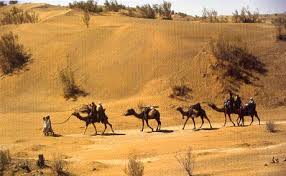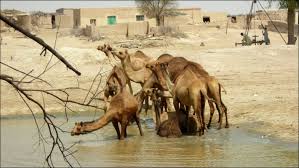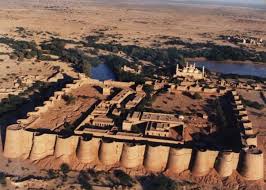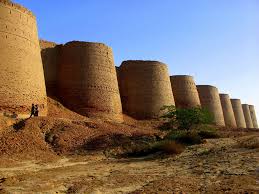THE DESERT:
East of Bahawalpur is the Cholistan Desert .The region was once watered by the Hakra River, known as the Saravati in Vedic times. At one time there were 400 forts in the area and archaeological finds around the Darawar Fort, the only place with a perennial waterhole, indicate that it was contemporaneous with the Indus Valley Civilisation.
Cholistan is locally known as Rohi. This famous desert is 30 Km from Bahawalpur and comprises of an area of 16,000 sq.km. which extends upto the Thar desert extending over to Sindh and futher to India. The word Cholistan is derived from 'Cholna' which means moving. The people of Cholistan lead a semi-nomadic life, moving from one place to another in search of water and fodder for their animals.



Its dunes as the name Cholistan signifies (Cholistan -derived from Cholna or walking) as they go on shifting with the tune of time and meteorology. All along the 500-km of dried up river are over 400 archaeological sites, which date back to the Indus civilization 4500 years ago and are clustered around Derawar Fort. The only perennial water hole in the desert. The desert has an average rainfall of 5 inches a year and there is very little cultivation.The origin of the Thar desert is a controversial subject. Some consider it to be only 4000 to 10,000 years old, whereas others state that aridity started in this region much earlier. Also known as The Great Indian Desert, it is spread over four states in India, namely Punjab, Haryana, Rajasthan, and Gujarat, and two states in Pakistan and covers an area of about 4,46,000 square kilometres. Deriving its name from 'thul' denoting the sand ridges of the region, Thar stands divided between Sindh region in Pakistan and Rajasthan in India.
The people living in the deserts are very hospitial & friendly. You must arrange a Camel Safari to the desert.
A sandy wasteland dotted with nomadic communities and wind-swept forts. Spread over an area of 15,000 acres, east of Bahawalpur, the desert extends into the Thar Desert of India. Cholistan was also called the land of forts because of approximately 400 forts in the area, some dating back to 1000 BC. Today the remains of Drawar Fort still remind the glory of old times. The chain of forts was built at 29 km intervals in three rows. The first line of forts began from Phulra and ended in Lera, the second from Rukhanpur to Islamgarh, and the third from Bilcaner to Kapoo. Ruins of some of these can still be found today. The local pastoral and nomadic populace is somewhat similar to those in Indian Rajasthan.
A sandy wasteland dotted with nomadic communities and wind-swept forts. Spread over an area of 15,000 acres, east of Bahawalpur, the desert extends into the Thar Desert of India. Cholistan was also called the land of forts because of approximately 400 forts in the area, some dating back to 1000 BC. Today the remains of Drawar Fort still remind the glory of old times. The chain of forts was built at 29 km intervals in three rows. The first line of forts began from Phulra and ended in Lera, the second from Rukhanpur to Islamgarh, and the third from Bilcaner to Kapoo. Ruins of some of these can still be found today. The local pastoral and nomadic populace is somewhat similar to those in Indian Rajasthan.
DERAWAR FORT:

Derawar Fort is located 48 Km from Dera Nawab Sahib. It is still in a good condition. The rampart walls are intact and still guarded by the personal guards of the Amir of Bahawalpur. The tombs of the ex-rulers of Bahawalpur and their families are located in this fort. The tombs have nice glazed blue tile work. Prior permission of the senior Amir of Bahawalpur is required to enter the fort. The fort was built in 1733. The fort with decoratively carved sandstone walls, which take your breath away, as they rise magnificently from the flat desert wasteland like something so grand it's difficult to imagine.It is extremely photogenic, but is best seen in the morning or evening before or after the desert's midday sun takes hold.


DESERT JEEP RALLY:

The most interesting event held annually the month ot March is the Cholistan's Desert Jeep Rally. it is held at famous Derawar Fort and vehicles covers the round about distance of 250 km. It includes the vehicles ranging from 1300 cc to 3000 cc plus. Thrillers gathers from all over the Pakistan to enjoy the spring in sand.
BY RABIA WAHEED
No comments:
Post a Comment